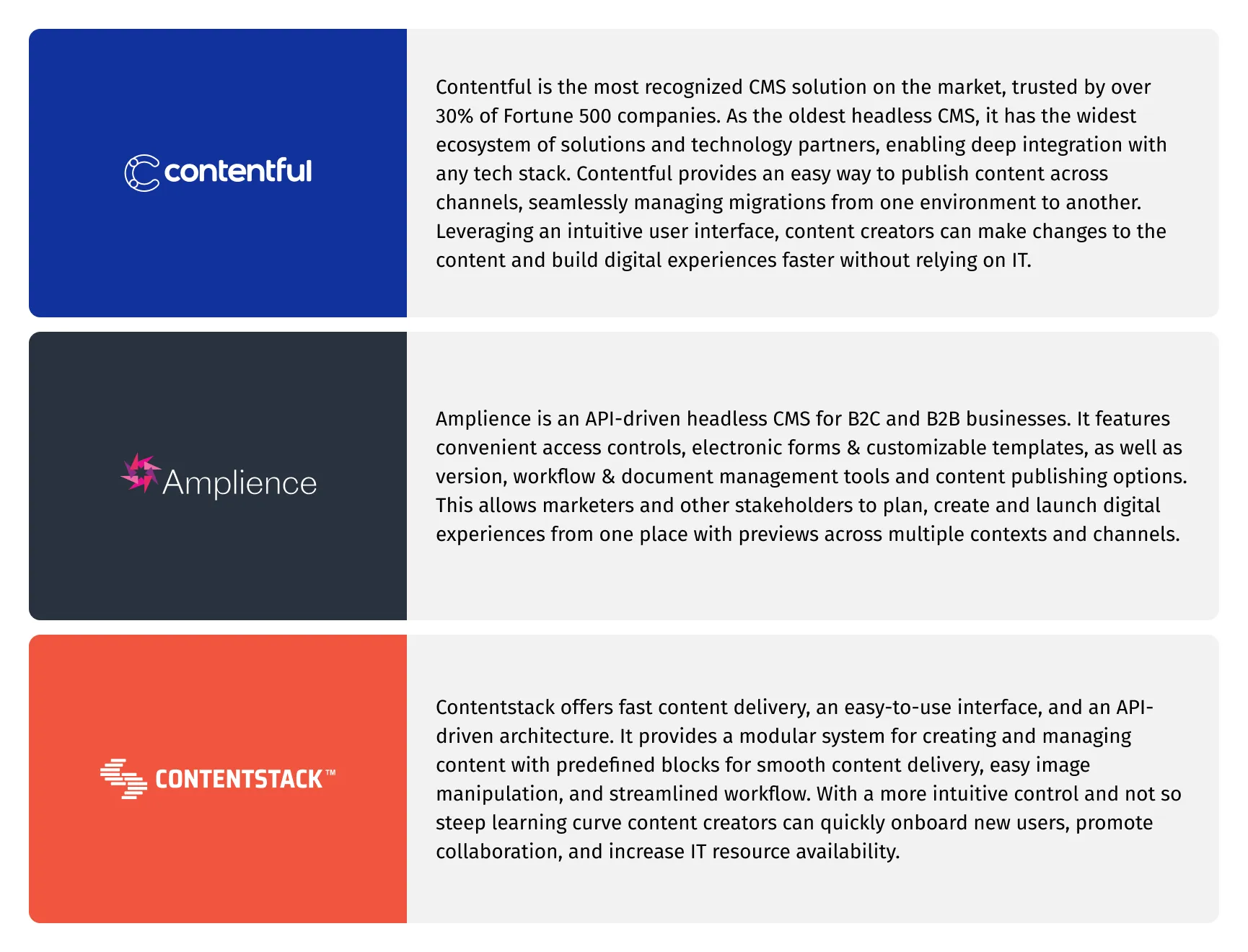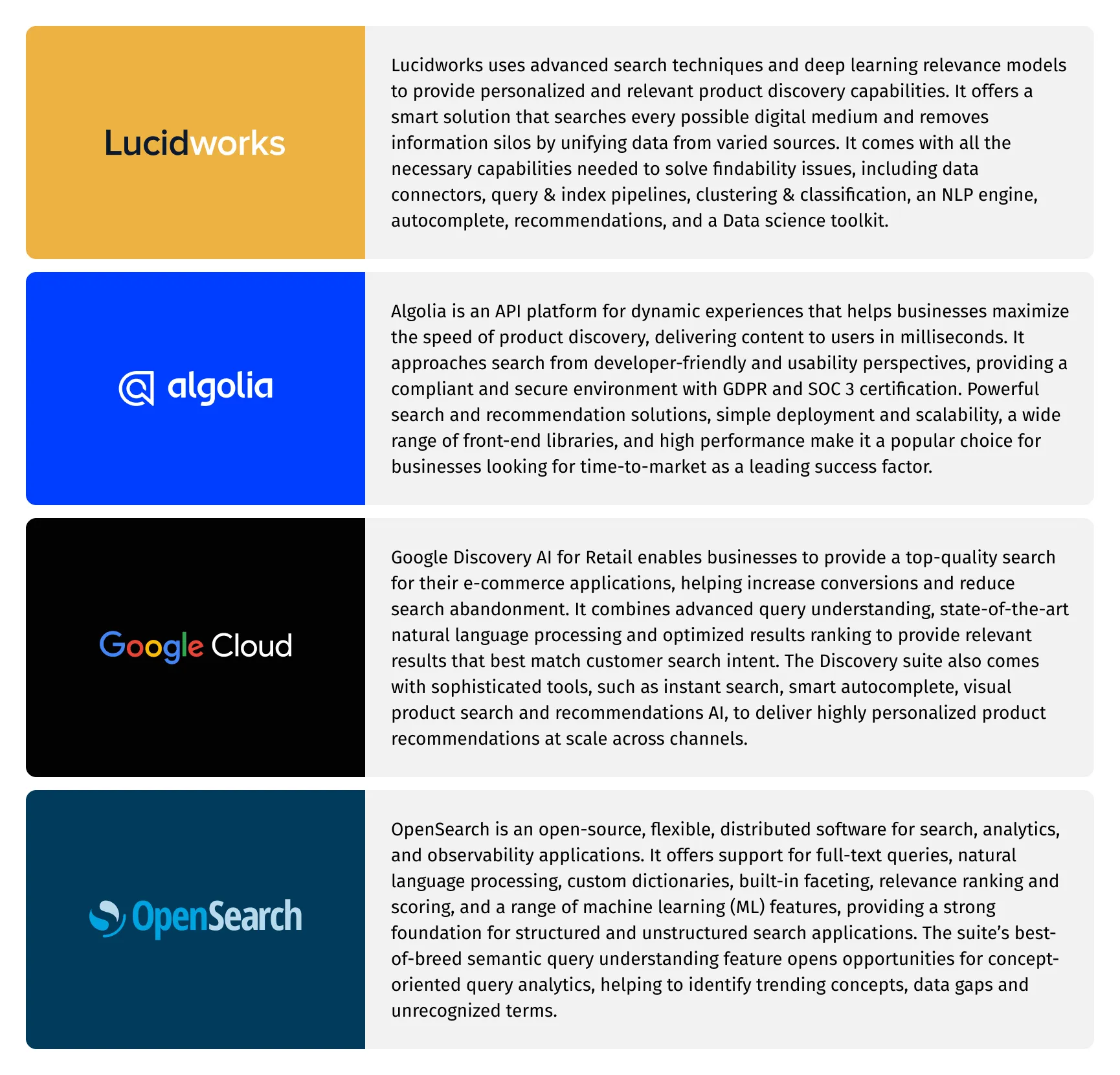
Beyond transactions: Key composable commerce building blocks to redefine customer experience
April 27, 2023 • 7 min read
Composable commerce is a game-changing concept that elevates online shopping to new heights. It represents a shift away from a platform-centric perspective to a customer-centric approach, emphasizing the importance of delivering a superior experience to the end user.
There are a number of elements that work together to provide seamlessly compelling customer experiences that drive conversions, leverage up-sells and cross-sells, and grow customer retention. In this article, we will focus on non-transitional business capabilities that lay the foundation of a winning digital commerce modernization strategy. These are – headless commerce, AI-powered search, headless CMS, and loyalty platform.
Headless commerce platform
E-commerce is playing an increasingly significant role in the digital economy, accounting for nearly 19% of global retail sales. By 2026, the share of the online segment is forecasted to reach close to a quarter of total retail turnover. To be a part of this trend rather than following it, businesses have to switch to more modular, adaptive platforms. That’s where headless commerce comes into play.
A commerce engine with a headless architecture allows companies to make changes to the customer-facing side of their online store without having to touch the business logic that controls shopping carts, inventory, shipping, payments, tax calculations, etc. This way brands can deliver exponentially deeper levels of customer engagement and orchestrate experiences that meet shoppers’ ever-rising expectations.
The decoupled nature of headless commerce platforms allows businesses to separate the customer-facing presentation layer (‘head’) from the back-end system (‘body’). In practice, this means they can store content and data in a way that’s not tied to any particular front end. This helps brands connect with clients wherever they are, deploying different user interfaces through multiple touchpoints. Such an approach comes with multiple benefits:
Tailored storefronts
Today’s customers are used to having the whole world at their fingertips, so you need to be able to provide a seamless experience on just about every channel imaginable. Modern digital commerce platforms have capabilities to synchronize data intelligently whenever the same person uses a mobile app, website, conversational chatbot, computer or any other IoT device to browse products and place an order.
Platform agility
Retailers cannot afford to react slowly to shifting behavior, making headless technology the perfect tool to address the mutable needs of the consumer. Since the headless commerce system’s front and back ends are not tightly integrated, they can be updated, maintained, and scaled independently. This means that any spikes in customer activity, for example during the holiday shopping season, have little to no effect on core commerce functions. Such a level of efficiency enables a faster time to value for both your clients and administrative staff.
Seamless integration
A headless commerce platform acts as the core e-commerce engine that enables the integration of multiple business capabilities under the same roof. This includes a user interface, all of the technical components of the store, e.g. shopping cart, order processing, checkout and shipping system, as well as other tools you use day in and day out, such as customer relationship management (CRM) and product information management (PIM) systems. With all the elements of the digital e-commerce platform working like a single organism, you can run the entire experience in ways that your customers never see.

Content management system
Enterprises that expect to survive and thrive in the age of digital shopping have to mark their online presence. As digital channels become a critical battleground for businesses to get connected with their clients, it is the content that becomes the main tool to voice their brand.Engaging, high-quality content can elevate a number of functions from delivering information and entertainment to potential buyers, building brand awareness, and driving traffic to your online store to increasing social selling, and diverting calls from customer service centers. Content is king, after all. And while this now-famous phrase was coined by Bill Gates almost 30 years ago, there has never been more demand for the continued creation, refinement, repurposing, and reformatting of information assets.
Content generation has always been the predominant task of the marketing department. However, today, content can come from the entire organization, including sales, product development, and the executive suite. To establish an efficient workflow for the design, management, and delivery of such an avalanche of digital messaging, businesses depend on content management systems (CMS).
CMS is a category of software that offers a content publishing chain, allows for the structuring of a website’s content, and provides the opportunity for several contributors to use the system simultaneously. It often comes with pre-built templates that streamline the process of creating, publishing, and updating web pages with new copy, images, videos, and more.
The development of MACH architecture cemented a new type of solution – headless CMS. Compared to traditional content management software, this technology disassociates content creation, modeling, and authorization from the display layer. By doing so, it can distribute your digital assets anywhere and everywhere you need them – mobile devices, tablets, digital signs, AR and VR gadgets.
With headless CMS, content managers no longer need IT support for back-end changes. They can make any modifications required to support omnichannel customer experience and campaign promotion without even the slightest influence on the rest of the e-commerce system.

AI-powered search
No matter how much effort you put into creating compelling web store content or how big your investments in marketing are, the truth is, if your customers can’t find it they won’t buy it. Today, shoppers expect instant, precise, relevant, and personalized search results closely matching their buying intent. And if they don’t see what they are looking for on your site, they will get it somewhere else.
This behavior is known as search abandonment. According to Google, bad online search experiences cost US retailers over $300 billion annually. Furthermore, 77% of consumers who had search difficulties in the past are likely never to visit the website again, while another 85% say they view the brand differently after experiencing such issues.
To stay on top of the game and differentiate customer experience by making it easier for shoppers to find products they need and love, companies need to adopt new approaches to producing personalized and context-driven search. Developing an advanced, feature-rich search engine calls for modern search technologies powered by AI which can leverage refined product data as well as information related to customer search and shopping behavior. These tech capabilities include:
Semantic query parsing
Semantic query parsing harnesses the power of natural language processing (NLP) allowing users to formulate precise requests that help search engines retrieve relevant results. This is achieved by analyzing product data and capturing the latent attributes to build possible interpretations of customer queries.
Semantic vector search
Semantic vector search (aka neural search) is a powerful self-learning product discovery technology that captures all available catalog data and customer engagement history, like metadata, images, reviews, ratings, prices and promotions. This information is then uniformly encoded and packed into the dense vector representation by the deep learning model. With the help of neural search algorithms, the retail search engine can go beyond keyword matching and leverage a conceptual understanding of the text.
Visual search
Visual search represents images with “fingerprints” or vectors that capture the most essential features of an image. Those vectors are created in such a way that similar images have similar fingerprints and are geometrically clustered together. This embedding trick allows the search engine to quickly find similar images by their vector representation.
Smart autocomplete
Smart autocomplete is an important gateway into retail search, as it is the first feature the customer encounters when interacting with the search box. This technology has built-in session intent awareness algorithms that enable it to suggest relevant query completions based on common phrases, typos, slang, and abbreviations shoppers use when browsing the online shop. This boosts search convenience by eliminating mistakes in search queries.
Recommendations
Recommendations provide relevant suggestions based on the user’s historical and real-time shopping and browsing behavior. The results that best match the buyer’s initial query are obtained through the combination of visual similarity-based recommendations, collaborative filtering with deep learning, session-based recommendations, and personalization algorithms.

Loyalty and promotion optimization
One of the major notions of the selling world is that it is more effective to keep recurring customers around for the long run than having to create new ones. Depending on the industry specifications, it can cost brands five to 25 times more to get a new client versus nurturing the existing customer base. That’s why businesses invest heavily in customer retention strategies.
90% of companies worldwide use some sort of incentive, be it discounts, free products, tailor-made offers, insider perks or exclusive experiences to reward clients who frequently interact with a brand. By leveraging AI-powered trade promotion optimization tools, brands can further personalize these bonuses, and automatically determine the optimal audience, communication time, communication channel, and other parameters, based on customer profile, current web session, channel, and other behavioral signals.
These enticements are meant to motivate repeat purchases, increase customer success, establish trust between buyers and businesses, and foster customer retention. They form enterprise loyalty programs, which are one of the most effective tactics for increasing conversions and building meaningful, long-term relationships with customers.
A robust loyalty management and promotion optimization software is tightly integrated with the analytics component of a composable commerce ecosystem, enabling engagement and bespoke loyalty benefits at any point on a customer’s shopping journey. It reflects the specifics of each company, enabling efficient integration, high data quality, real-time business intelligence and reporting.
The top-notch customer loyalty platforms are typically built on the following principles:
Reward customization
The tier and reward model has been around for quite a while, but to build a brand that truly resonates with your target audience you may want to rethink it. Therefore, loyalty platforms should provide you with flexibility and freedom to offer traditional financial rewards, like discounts, coupons, or gift cards, as well as experiential rewards that involve a certain level of personalization and gaming system.
Proactive customer engagement
Your loyalty platform should support engagement options other than just placing orders. These may include reacting to campaigns, inviting friends, social signaling, writing reviews, and exploring various features of the website.
Real-time insights
Turning shopper loyalty into a brand opportunity wouldn’t be possible without predictive analytics and reporting features. They allow companies to monitor loyalty program metrics, like membership totals, quality and quality of customer interactions, purchase frequency, program adoption rates, and reward redemptions. These data can be leveraged to improve your offerings, boost campaign performance, and impact buyers’ spending behavior.

Summary: Maximizing the potential of composable commerce
Composable commerce is poised to create ever-greater productivity gains in the world of retail. It grants brands the freedom to choose best-of-breed solutions for every component of their business, empowering them to make rapid changes to their technology stack, create a scalable, omnichannel, and personalized customer experience, and ensure they stay competitive in today’s rapidly-changing market.
As composable commerce technology advances, so will the building blocks that are a mainstay of its success. Headless commerce, AI-powered search, headless CMS, and loyalty platforms are set to become one of the most interesting developments in the upcoming years. Together they can unlock the full potential of digital commerce and take your business to new heights.
Get in touch and our team will help you create a winning composable commerce platform that drives customer experience and business growth!





